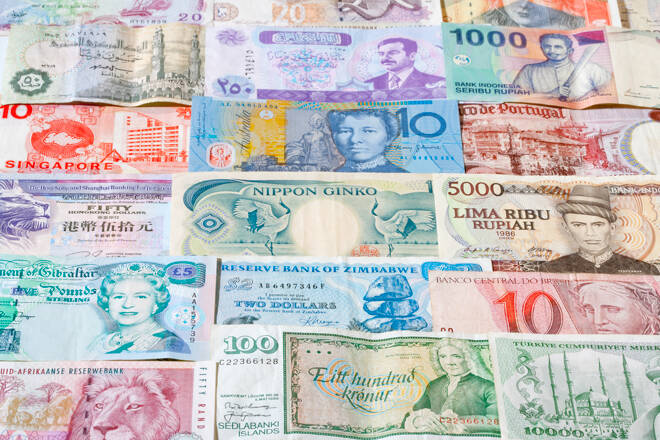Advertisement
Advertisement
GBP/JPY Vs GBP/USD and USD/JPY – March 6th, 2021
By:
Week 6 for JPY cross pairs to remain deeply overbought and not falling despite drops to attachment pairs.
GBP/USD last week fell 236 pips from 1.4015 to 1.3776 while overbought GBP/JPY rose 257 pips from 148.14 to 150.71.
Known since the 1930’s, the Japanese pegged GBP/JPY to UK Gold for not only economic viability but the first incursion to the western world of finance. The standard to hold GBP/JPY to the UK held throughout Bretton Woods. Upon the 1972 free float, GBP/JPY became attached permanently with high +90% correlations to GBP/USD.
All JPY cross pairs followed with high and positive correlations as AUD/USD and AUD/JPY, NZD/USD and NZD/JPY, EUR/USD and EUR/JPY while USD/CAD and CAD/JPY became polar opposites as both permanently correlate negatively. USD/CHF and CHF/JPY traditionally also hold opposite correlations.
The Japanese offered not only a double trade but GBP/JPY and GBP/USD as the same exact currency pairs. The same principle holds true for EUR/JPY and EUR/USD, AUD/USD and AUD/JPY and NZD/USD and NZD/JPY. The double trade is permanent for USD/CAD and CAD/JPY.
Why JPY cross pairs remain overbought into week 6 amd not falling with counterpart currencies is the USD/JPY problem to correlations. While GBP/USD correctly correlates to GBP/JPY at +94%, GBP/JPY also not correctly correlates to USD/JPY at +83%. A further problem exists as GBP/USD correlates to USD/JPY at +46 %. All correlations are not only running positive but this situation is the exact same for AUD/JPY, NZD/JPY, EUR/JPY, CAD/JPY and explains why prices remain high and overbought.
Positive correlations are the result of exchange rate prices and relationships to moving averages since correlations are found within the context of averages. USD/JPY trades above vital 105.70, GBP/USD above 1.3697 and GBP/JPY above 144.80. Correlations are positive because prices trade above respective high / low averages.
Required to assist GBP/JPY to drop is GBP/USD breaks 1.3697 or USD/JPY trades below 105.70. GBP/JPY then decides to fully correlate to USD/JPY or GBP/USD. GBP/JPY in every instant follows GBP/USD as the 91 year correlation and order of currency markets.
Current GBP/JPY trades 1156 pips above GBP/USD and 2506 pips below GBP/CAD. GBP/JPY larger range from GBP/USD becomes 144.08 and 1.5564. GBP/JPY above is located the 14 year average at 155.38 and the 10 year at 148.36.
Prior to the 2016 interest rate changes by the central banks, the market order to currency pair arrangement existed as GBP/USD, GBP/JPY, GBP/CHF then GBP/CAD.
The new order is arranged as GBP/CHF, GBP/USD, GBP/JPY then GBP/CAD and seen as GBP/CHF 1.2855, GBP/USD 1.3820, GBP/JPY 149.86 or 1.4986 then GBP/CAD 1.7292. Much daylight exists for GBP/JPY to trade freely between GBP/USD and GBP/CAD yet 250 pips traded last week from a distance of 1100 and 2500 pips between exchange rates.
Why GBP/CHF and all currency pairs arranged as Other Currency / CHF dropped from contention as support is due to the uniqueness to the SNB’s interest rate system. Libor is miles from actual interest rates as first comes Saron, Call Money rates and the most vital Debt Register Claims.
JPY cross pairs overall contain downside moves from GBP/JPY at 300 pips and 200 for AUD/JPY and NZD/JPY.
USD/JPY for the week is not only light years overbought but the 5 year average is located at 109.01. A good target is found at 106.65.
GBP/JPY big break lower is located at the 10 year average at 148.38. A break then GBP/JPY trades 146.00’s easily.
GBP/USD this week opens between 1.3768 and 1.3840. Below 1.3768 challenges most vital 1.3697, above 1.3840 then GBP/USD travels much higher.
GBP/CHF and GBP/CAD run good and positive correlations at +93% and +96 % for GBP/CAD. For GBP/NZD and GBP/AUD remain problems as correlations run negative at -43% and -64% for GBP/AUD.
GBP/JPY
Included are GBP/JPY moving averages from 5 day to 253 days. The averages are perfect and derived from the ECB. The first number is the day average followed by trading days then the average.
A 20 day average is actually 15 days, a 50 day average is actually 36 days. Trading day averages to factor perfectly start at the beginning of every year then the numbers increase as days trade. A 50 day average is most stable as it only trades 36 to 50 days.
A 5 day average begins Monday at 2 days, then 3 for Tuesday and Wednesday and 4 for Thursday. A full 5 day average only trades on Fridays.
5 Day 5 149.2391
10 Day 9 149.1325
20 Day 15 148.3808
50 Day 36 145.2691
100 Day 71 142.5398
200 Day 143 139.9417
253 Day 180 139.1231
As GBP/JPY trades lower then the averages drop.
Targets
Targets are not only known miles ahead but targets stack to watch trades unfold.
Current targets: 149.7549, 149.8496, 149.5086, 148.1852, 146.0887, 143.7901, 143.0356.
The ECB and most central banks factor exchange rates to 6 decimal places and 4 for USD/JPY and JPY cross pairs and I follow the ECB exactly.
About the Author
Brian Twomeycontributor
Brian's published works include John Wiley 2011 "Inside the Currency Market", Using Z Scores to Trade Foreign Exchange, 2012. Academic Paper: 2015, A case study in carry trade and cross pair allegiance switching, pre and post 2008.
Advertisement
